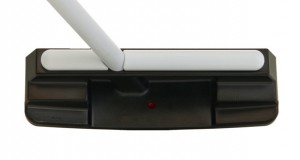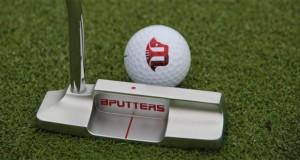The Radi-Eye by Precision Putting Products is a new putter that aims to change the face of putting. Indeed, the face of the putter features a radius from heel to toe to provide true roll as well as enhanced forgiveness.
In fact, according to the company, the Radi-Eye putter will eliminate up to 4.5 degrees of push or pull during a putt: “We set out to design a putter that would stop us from pulling and pushing putts, especially the short ‘money putts’ that put all the pressure on you. The Radi-Eye is the ultimate putter to forgive the mistakes that we make day to day on the green.” We caught up with Alec Lockavitch of Precision Putting Products to learn more about this putter. Following is our exclusive interview:
In simple terms, can you describe the unique face of the Radi-Eye putter?
What makes the face of the Radi-Eye putter so unique is that the face has a radius that runs from heel to toe that forgives the user of their mistakes. The face also has no loft, which ensures that you always strike the ball at center or above. This always gives you that sought-after overspin without having to press your hands forward at address and to try to maintain that position through the putting stroke just to take the loft off of the face.
How is your putter different from other putters with radius faces?
The other putters have a radius that runs from top to bottom, and not heel to toe. The top-to-bottom radius is only for overspin, and not for forgiveness. I also think there was a company overseas that played with the idea of having a radius to help with forgiveness, but they were way off the mark. Over the four years that we researched this putter idea, we made prototypes with different sizes of radiuses and that research led us to the final product.
How does the face work to keep balls on the target line even when the face angle is open or closed at impact?
The Radi-Eye putter uses a radius on the face of the putter that runs from heel to toe, so as the face opens or closes at impact, the ball still goes down the intended line. With a flat faced putter the ball always moves at an angle of 90 degrees of the face, and there is no room for error. We have studied all types of putting strokes–inside back and inside through like your golf swing, inside back and down the line, and straight back and straight through–and we discovered that all of these strokes open and close the putter face, which means that there is only one spot in your stroke to make a perfect putt. If you miss that spot, then you either push or pull the putt and to make things worse, that’s without opening or closing the putter face by torque in your wrist, shoulders, arms, back, turning your waist, tilting your head or being off balance. Imagine that you have a framing square on your putter face. If you move the putter left or right, the square will always point 90 degrees off of the face.
Now, imagine if the face of the putter has a slightly rounded face, and as you turn the face it still looks like it is in the same position. That is why the ball maintains the original line, which builds confidence on the green. You can be so confident in those short putts that you can be very agressive and drive the ball into the cup, Tiger-like, and it doesn’t stop there. As you gain confidence with the putter, your chipping circle of comfort begins to grow larger and larger, which gives you more confidence chipping. This also starts to affect your approach shots by giving you confidence to get up and down, then back to the tee box which means more fun on the coarse and less stress!
Where did the idea come from—and was it hard to get USGA approval?
The idea came from missing those short money shots that put you under pressure and cause you to have the yips. I was so tired of hitting the ball well from tee to green just to blow it by missing three, four, five and six foot putts for birdies and pars. The idea came in a dream after long days of coming up empty. I always say it was a gift from God, because man could never make something this forgiving and perfect.
As for the USGA approval, sure it was tough. They have a lot of rules that you must maintain, and even when you think you have it right there is always that little shadow of doubt in the back of your mind that you may have made a mistake somewhere. But I guess that all those years of R&D paid off in the end, because we got through the first time around.
Can you describe the differences between the two available models?
The pro model is machined on a CNC milling center and the standard is a stainless cast model. Machining a putter from one piece of steel is a costly process, so keeping the customer in mind, we made the standard. The forgiveness is equal on both models, but we get a softer feel from the steel we use on the pro model.
 PutterZone – Best Putter Reviews
PutterZone – Best Putter Reviews




